
The following is part of Now Loading, a series that renders verdicts on whether or not your favorite video games deserve a place in the canon of works that have contributed to video-game storytelling in landmark ways. Read the series’ full mission statement here.
“I, like God, do not play with dice and do not believe in coincidence.” –Scott Cawthon, Before Coincidence Handed Him the World on a Silver-Eyed Platter
Ladies and gentlemen, children of all ages beneath thirteen, hello and welcome to Now Loading…The Video Game Canon! The only weekly Internet column that takes a look at games from the past to determine whether they should be remembered in the future.
Well, Dear Reader, we’ve taken a look at a number of interesting games in the past few months, and while it seems like a fair number of you are enjoying the series so far, it would also seem that a fair number of that fair number of you are wondering why so many of the games I’ve been examining have been making it into the Canon.
Well, in keeping with this month of spooky games, the answer to that question just might scare you.
For you see, ladies and gentlemen, just like many creatures of the night that crawl from the inky blackness of our collective unconscious, I am a sort of monster. My life is spent ‘neath the moon, ruminating on the merits of good games and exalting them for all the wonderful things they have to offer the interactive medium. And yet, with each word of praise that falls from my lips, a sizable drop of vitriol forms in my mind and is stored away like some sort of… Hate Camel.
Yes, that’s right… For you see, with all the good that can come from games, there is just as much banal misery to be found within the confines of those ones and zeroes, and I must release the valve every now and again lest we all suffer a fate worse than death. The nature of that fate, you ask? Well, like Howard Phillips Lovecraft before me, I dare not speak on it.
I will, however, tell you that Five Nights at Freddy’s is an absolute garbage franchise that I hesitate to refer to as a game, and that this lazy, predictable, boring dumpster fire has only become a household name because of an incredibly fortunate (yet unfortunate) confluence of events that kept its insipid excuse of a creator pumping out sequel after sequel until even he seems to have realized that the true horror he hath wrought is not in the “horror game” he made, but rather the infuriating impact on storytelling that his dumb jump-scare simulator has had on not only horror games, but also on a large chunk of the independent development scene.
In his house at Fazbear’s, dumb Freddy lays collecting his residuals.
Let me be very clear here: Five Nights at Freddy’s is a terrible game that we only know about today because of Let’s Players, Internet Theorists who gave the “story” more credence than it ever deserved, and a young fan base who appear to be equal parts scared of and in love with the animatronic monsters that wander the halls of this haunted pizzeria.
This will not get into the Canon even in the sense that it is so bad that we can learn something from it. This game, and its creator, Scott Cawthon, are flukes: benefactors of Fortunia’s Wheel turning their way time and time again, without neither rhyme nor reason. This canon piece will not strictly be about what works and what doesn’t work in the game, but rather about how the seeds of horrible trends are planted with vague, dime-store, mystery-novel-writing hands.
Are you sitting comfortably? Then let’s begin.
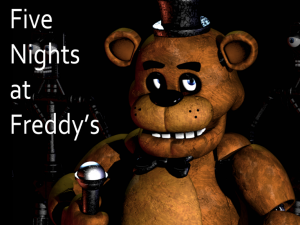
This is actually the cover.
In the interest of being frank, let me tell you right now that we will only be looking at the first entry into this seemingly endless series because, as I see it, it was the inexplicable interest in this first game that led to the explosion of the franchise. Furthermore, the project of Now Loading is to take a hard look at one video game at a time, so raising arguments based on elements from the piss-poor sequels we got for this game will not sway me one iota.
Five Nights at Freddy’s is a “survival horror” game released on Steam on August 8th, 2014 to near instant success, which is a blight on humanity’s collective soul that I will explore further down the line. It was written, designed, developed, and produced by “game developer” Scott Cawthon, a man whose unbelievable monetary success and keen ability to franchise are rivaled only by George Lucas himself.
Now, there is a very easy comparison to be made between Scott Cawthon and two previous auteurs we have discussed: Toby Fox of Undertale, and Satoshi Tajiri of Pokémon. All three share an interest in video games as a medium, all three dabbled in game development before their big success, and all three had an intense degree of control when it came to the games they were creating. Where they differ, however, is in the quality of their content and their ability to produce well-crafted masterpieces. By my own criteria discussed in those two aforementioned articles, I have no choice but to classify Scott Cawthon as a video game auteur for the way he put his blood, sweat, and tears into this game that he alone funded and created.
But you know what, Dear Reader? That also means that director Ed Wood is an auteur, which is a fitting analogy considering Five Nights at Freddy’s has all the polish and aplomb of Plan Nine from Outer Space.
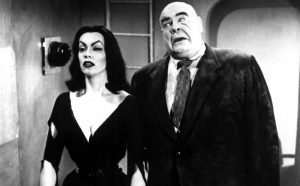
At least Plan Nine had shots like this.
Being an auteur simply means that you fall into certain patterns and use certain tropes that define your style as distinct from everyone else’s. In the case of Toby Fox, Undertale’s writing and characterization is like no other game’s. Satoshi Tajiri’s Pokémon games are drenched in childhood-wonder themes of bettering oneself through exploration and growth. Scott Cawthon has a penchant for tricking players into thinking his games are deeper than they really are, by alluding to a greater mystery, the answers to which he can’t be bothered to come up with.
Auteurs can be hacks, Dear Reader, and Scott Cawthon is right at the top of Hack City.
Now is the point in my article when I emulate every other Five Nights at Freddy’s commentator and bring up the fact that the game Cawthon made previous to this one, Chipper and Sons Lumber Co., was such a critical and commercial failure that it nearly caused him to pack up his game-making tools and head for a life of suburban fatherhood. And yet it was the wise words of Jim Sterling, the first of many YouTubers to lend their influence to this eventual franchise, that urged Cawthon to make a much scarier game. The animal characters in Chipper and Sons Lumber Co. looked so rubbery that they seemed like sentient animatronics, and so they gave off a much creepier vibe than old Scottie had intended.
This, Dear Reader, is the first of many coincidences-originating-from-failure that propelled this stupid game to super stardom. Cawthon’s game had faults, a critic lampooned those faults, then Cawthon took those faults and, instead of improving on his own skills, simply refashioned those faults and put them into a new game where the FAULTS WERE THE MAIN COMPONENT OF THE GAME.

“But Canon Boy!” I hear you all shouting fervently, assuming my title is Canon Boy, “You lauded Silent Hill for working within its limitations to make a better game, so why won’t you give Scott Cawthon the same slack for Freddy Fivenights?”
Yes, Silent Hill took its weaknesses like the low rendering capability of the PlayStation and turned them into strengths, but that was a creative way around a limitation that they could not resolve. The fog covering up the slow rendering became a staple of the series after the fact. Team Silent didn’t look at the PS1, realize it had low rendering capability, and then say, “Well you know what we oughta do? Make a game about low rendering capability!” Scott Cawthon was told he had a fault, refused to improve upon that fault, and instead simply made a game where the fault seemed like a feature. Sure, it was a deliberate choice, but so is driving stick and keeping the car in first gear the entire time even after your Dad told you not to do that. Yeah, you’re technically driving the car, but you’re doing a horrible job of it.
My vitriol hump is just getting deflated, so hop along this Hate Camel and let’s look at the game itself.
Story and Characters: I Have Run Out of Quotation Marks
TAKE ONE: WHAT SCOTT CAWTHON DECIDED ON
Okay. Here we go. I’m going to tell you the spooky story of Freddy Fivenights, and you’re going to have no choice but to agree with me because the literal text of the game is so barebones, skeletons are telling it to cover up and be a bit more modest.
You “play” as a character named Mike Schmidt, who has just started a job as a night-shift security guard at a pizzeria/arcade/Chuck E. Cheese knockoff. You are told by some guy on the phone (whom fans of the series have brilliantly named “Phone Guy”) that the animatronic mascot characters that play in the stage band for the kiddies get off the stage and wander around the place at night so that “their servos don’t freeze.”
This would be fine, except that when they see a human at night, they assume that the human is a robotic endoskeleton that is outside of its suit; so, if they catch you, they will forcibly stuff you into one of the robot costumes. Again, you’d think this would be fine, except that there are tons of motors, gears, and other mechanical gadgetry lining the insides of those suits, so being shoved into one is like being trapped in an iron maiden. The objective of the story is simply survive five nights of your security shift without being stuffed into a mechanical suit.
Also, Phone Guy hints that there were a number of kids who went missing, and that parents complained about strange smells and weird liquids leaking out of the animatronics’ facial features.
Ooky spooky.
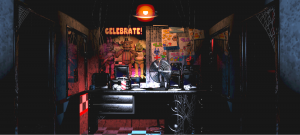
EXPERIENCE TRUE TERROR! NOW AT THE OFFICE!
TAKE TWO: THE DECISION-MAKING PROCESS
There are so many noticeable, grade-school rewrites that Scott Cawthon no doubt made while coming up with the “story” of this game that I almost feel like a bully pointing them out. I’m going to lay out for you what I think the thought process of the story development was here, because I think it’s indicative of a bigger problem in Scott’s storytelling capabilities that I will explore later in this article.
So, first, Scott clearly came up with the gameplay idea. Now, Dear Reader, enjoy Scott Cawthon’s Inner Monologue Theater:
Sit the player in a room and do not allow them to move. Have a threat constantly trying to get into their room and give them limited means through which they can avoid that grisly fate. Okay, so far so good, but we run into a problem: What is the threat?
All right, well, that Jim Sterling guy said my characters look like creepy animatronics, so let’s make the threat be these demonic robots hell-bent on killing the player. That’s good, that’s good… but why do they want to kill the player?
Oh! I know, they are capable of delineating between robots and non-robots, and they stuff people into empty suits if they think they’re non-robots! Huh. But wait, why don’t they do that during the day when they see all the kids in the restaurant? Hmm… well, it only happens at night! Wait, but why would these animatronics even be an issue at night? Oh, duh, I’ll say that the owners don’t want their servos to lock up, so they can roam freely at night! Robots have servos, so that’s a perfect fix.
So we’re nearly done coding here, and… oh, wait. Why would being stuffed into a suit be such a bad thing? I mean, if it’s just an empty mascot suit, people wear those at theme restaurants all the time, no problem. Hmm…well, what if the empty mascot suits actually have like, gears and wiring in them? Like they aren’t suits, but they’re empty robots? Yeah! And that way, if the robots see a human, they think it’s a robot out of its robot suit, and they’ll shove it down into a pit of broken wires and stuff! Damn, this game wrote itself.
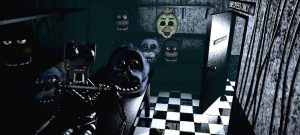
“Booooooo! Get F****d!”–Harry S. Plinkett
And, scene.
Now who knows, maybe it didn’t happen like that. Maybe Scott Cawthon had it all planned out from the beginning, and his weird writing choices were all in service of later installments, and the puzzle of convenience would all come together at the end of Five Nights at Freddy’s 12: The Freddening. Maybe I’m wrong and millions of fans are right, and he’s the enigmatic writing genius that everyone thinks he is.
Maybe, but no. Nope. He’s a hack who can’t write.
Speaking of which!
Gameplay, Visuals, and Music: I’ll Take “Three Things We Don’t Have Here,” Alex
Due to its nature, horror is allowed to be a very ambiguous genre. In fact, vagueness and ambiguity often help make something even more terrifying than the author may have originally intended. The classic example here is the shark in Jaws, which was famously made even more terrifying because we couldn’t see it for the majority of the movie. The human mind is capable of conjuring far scarier things than any outside stimulus can, and it is our own thought processes, anxiety, and paranoia that truly scare us when we engage with a horror story.
- Where did the man with the hook go?
- What are the Old Ones doing?
- What the hell happened at Amigara Fault?
We’ll never know, and that’s what terrifies us.

What doesn’t terrify us is loud, obnoxious screaming that we know is coming. Five Nights’ gameplay, if you can call it that, includes keeping the power running so that you can look at your cameras so that you can keep an eye on Freddy and Friends, so that you can close the doors on either side of you when they are about to run in and scare you to death.
So here’s the thing, Dear Reader: I will give kudos to this game because it keeps you planted firmly in one spot, giving you no choice to run away from the monsters that are trying to chase you. In pure horror terms, this is a great idea. It turns the whole scenario into a sort of waking nightmare from which there is no escape, and it takes away the one instinctual piece of agency that every one of us has deep down within us: flight. Where the game completely wrecks this interesting concept is with the implementation of jump scares.
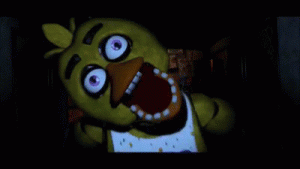
This is what you’re all so scared of.
The only penalty you have for death, the ONLY penalty, is a jump scare. A loud, startling noise, complete with one of the animatronics jumping in your face. This is such a cheap tactic that I’m even surprised by my dime-store novelist straw man using it in the first place.
Imagine how much more terrifying this game would be if you were locked in place and something steadily creeped into your security room. You know it’s there, doing something, but, as if you’re in a bout of sleep paralysis you can’t run away, you can’t move. You can’t even scream.
But nope! It’s a loud noise, blasted at full volume to catch you off guard. Except even this fails after a while, because once you know what’s coming, even the jump scares lose the power to startle you. There is nothing redeeming about the scares in this game. You may as well be slamming your hand down on a joy buzzer every time one of those stupid robots pops into your field of vision.
The visuals are, shock of all shockers, rubbery and stupid-looking. I will admit that the atmosphere of the derelict pizzeria is pretty creepy, but with a giant bear, duck, bunny, and fox running around it, the scary sheen sort of falls away after a while. See, animatronics are kind of like clowns. You can claim that they scare you all you want, but I just refuse to buy the fact that anyone is creeped out by them to the point that they are viable horror icons.
This is the part of the article where I usually talk about the game’s music, but there is no music in this game. I would usually make a point to discuss the ambient sound in place of the music, if there is any, but Five Nights’ ambient music is so generic and “spooky house” themed that I swear Scott Cawthon got one of those “Fifty Haunted House Tracks to Boost Your Halloween!” CDs and only used the “creepy breathing” track. With the odd exception of distorted laughter being played in either one of your headphones, there’s not much to speak of musically in this game except for a boring, dull hum that persists throughout the entire game. Oh, and I guess the constant, high-pitched screaming from the jump scares.
There is nothing redeemable about the gameplay, music, or visuals in Five Nights at Freddy’s.
Nothing.
Impact on Gaming and Culture: Go Straight to Hell, YouTube
So we all know that this game took off straight to the moon and was followed by a number of quickly released sequels that were all basically the same game, and that there were two novels released and a movie coming out whenever Warner Bros. stops raking in the cash from IT. And if you didn’t know about all that, that’s pretty much what you need to know, as far as I’m concerned. I’m far more interested in how this hot garbage pile of a game actually made it as far as it did in the first place.
Ignoring Jim Sterling as the proto-culprit who inadvertently inspired Scott Cawthon to make a horror game, the first person to really popularize Five Nights at Freddy’s was the YouTube Let’s Player, Markiplier. Mark played this game just two days after its initial release, titling the video “WARNING: SCARIEST GAME IN YEARS”, which naturally attracted the attention of his millions of subscribers, who subsequently clicked on it and lost their minds.
Why? Well, I can only assume they were reacting less to the game and more to Mark’s charming overreactions as he played it. His hyperbolic way of playing games naturally endears you to him, and, through a weird sort of transitive property, that endearment rubs off on whatever game he is playing. That first video he put out currently has 62 million views, which is by far the most viewed video he has. Those numbers are very attractive.

See? That’s charisma, baby.
Naturally, this led to Markiplier completing the game, and those views essentially soul-bonded him to the concept of playing every single sequel that would ever be produced. And I have to say, Dear Reader, that I don’t blame Markiplier for the massive explosion of popularity that this game had. He played the game and put out a number of videos referencing the game to garner views, but they were all quality videos that were enjoyable to watch. Like I said, Markiplier is immensely likable, so it’s not too hard to believe that those videos would be successes. And what’s more, Mark never once even hinted at the idea that this game was more than it was. He played the game, he was spooked, and that was it.
Had it ended there, I wouldn’t be talking about this festering pustule. No, it’s what came after. It’s all the hype-mongering, lore-theorizing, seeing-more-than-what-was-there tomfoolery that really inspired Scott Cawthon to keep making these games, and keep making more and more money.
Enter Game Theory and MatPat.

“Are you sure you want that to be the photo? You’re serious? All right, whatever.”
It started with one video callously comparing the events of the game’s “hidden lore” to a real-life shooting that took place in a Chuck E. Cheese. The connections were tenuous at best, but the video gained a huge following. Suddenly, “Game Theory” rapidly became “Five Nights at Freddy’s Theory,” with each new installment of the series bringing in a new “theory” video from MatPat. The views skyrocketed, and Scott Cawthon seemingly kept making the games just so that MatPat and others like him would keep making videos about the increasingly vague storyline that the games kept shoddily cobbling together. Soon it became an arms race between MatPat and Scott Cawthon, the former trying desperately to piece together the lore, timeline, and basic plot that the latter was thinking up on the spot. And maybe it was because they were so deep into it at this point, or maybe it was because the videos that MatPat produced and the games that Cawthon made were just too profitable at this point, but both of them refuse to admit the simple truth that there is no story.
There is no grand design slowly being pieced together by Scott Cawthon. There is no true timeline of events, there is no true identity to the hinted-at child killer from the first game, and there is no point to any of this—other than a perpetual boost to the creator’s ego, as well as his wallet. No amount of obfuscating the plot will change the fact that Five Night’s at Freddy’s is a poorly designed, bad game.

This retro avatar will give me legitimacy, right?
BONUS LEVEL
Nope.
VERDICT: What Do You Think
Well there, ladies and gentlemen: my vitriol hump has been exhausted, and this Hate Camel will recede back into darkness of the night. I cannot wait to hear all the people who are no doubt already chomping at the bit to tell me just how wrong I am, and that the story behind these games is too complex and terrifying for my little mind to understand. To those people, I wish a swift recovery from their delusion, and a deep shame for trying to defend a horror game that is so objectively broken that it has used the very mechanism in your brain that typically allows for horror to work and turned it on its head completely. This game is so laughably bad, with just enough vagueness in its storytelling, that it has actually convinced people that it is good.
If only it could have used this power in conjunction with a functioning horror game, maybe I would have one good thing to say about it before forcibly returning it to the weeds.




3 Comments
Gabe Simms · February 11, 2018 at 4:54 am
Hey, I just stumbled across this website. I love the idea of on ongoing academic analysis of video games as a story-telling medium and I really like the idea of a video game story-telling canon. This article was for some reason the first one I read, however, and I’m put off by your analysis. I think of a lot of your criticism of this game is uncritical and preferential, not to mention mostly unrelated to how it contributes to video games specifically as a story-telling medium. It’s also rather condescending. It’s difficult to interpret an actual academic criticism from your writing when you openly acknowledge that it’s fueled by “vitriol.” I mostly take issue with your claims that the game isn’t scary and that Scott Cawthon, who you seem to have some personal animosity towards, is a terrible story-writer.
I don’t particularly care for the gameplay of these games either, never even bothered to finish the first one, mostly because I agree that the jumpscare tactic has limited potential. But it’s incredibly uncritical of you to say that the animatronics aren’t scary simply because you “refuse to buy the fact that anyone is creeped out by them.” That’s not evidence or analysis, that’s superiority and rudeness. Fear is entirely subjective and belongs to the realm of qualia. First of all, what causes people to feel fear is going to differ from person to person, and what doesn’t scare you may terrify someone else. And the genre of horror is about much more than just showing us things that are already scary. If a subject matter had to be inherently frightening, than many classics of horror would never have been made; Alfred Hitchcock’s “The Birds” comes to mind. Horror often succeeds most when it turns familiar things into threats. I found the animatronics to be incredibly unnerving, and based on the reaction of the internet, so did many, many other people. You can “refuse to buy” that, but denial of a reality is hardly a valid foundation for criticism.
I also don’t understand your harsh condemnation of Scott Cawthon. Your position that he built the entire game on a “fault” of his previous game is not really true. An inappropriate art style, maybe resulting from inadequate skills on the part of the creator, caused Cawthon’s earlier game to be creepy in a way he didn’t intend. That was definitely a mistake, but taking that graphical style and creating something with it that it actually contributed to isn’t lazy or “a hack.” We actually call that creative and innovative. A great many inventions were born the same way – take super glue. The guy that invented it was trying to make a clear plastic to use in gun sights during WWII. It didn’t work at all, but he did make super glue. Is it a hack that we took that “mistake” and used it for a different application? I’m not saying Cawthon created a work of genius, but you’re criticizing a process that we praise in many other creators, even other game developers.
For the most part, I would agree with you that Cawthon’s game is fairly forgettable, though I don’t know why that bothers you so much. But where I really disagree with you, and where I think you missed a giant opportunity to discuss a possible contribution the FNAF series did make to the story-telling of video games, is in the story. You claim that there is no deep lore to the story, and that Cawthon just makes it up as he goes along. I won’t argue with that – but not only is that not a bad thing, it’s the one reason FNAF is noticeable and maybe important. (I’ve heard before many times the fallacy that if a story was made up as it went along that means it’s a bad story, and that’s simply not true. Improvised stories can be incredibly well-told and enjoyable.) It doesn’t have a great story, but that story did have an impressive conception process. Five Nights at Freddy’s is an interesting situation where it appears that a small-time, independent developer captivated the attention of thousands of people, who began to theorize about his game, and then that developer fostered a relationship with that community that had a significant impact on the development of future games. The story of FNAF is horribly cheesy and convoluted, but it was a colloborative creation of a large community. And that’s not only fun, it’s an intriguing model for how indie games could evolve, if Cawthon and the FNAF community’s accidental Frankenstein development were to be formally replicated. It almost reminded me of a traditional RPG, like D&D or Pathfinder. Imagine if a game developer was also a GM, and his fans/playtesters were the players in a campaign that was being translated/developed into a video game. And imagine if that video game was high-quality and enjoyable to play, unlike most of FNAF. Cawthon’s games may not be good, but the development of them was extraordinarily open to the fans, ALL fans, across Youtube, Reddit, Tumblr and elsewhere. You can tell those fans to “go to hell” for creating something that offended you, but don’t dismiss a creation story that lessons could be learned from and that has implications for potential developments in the medium of video games.
Five Nights at Freddy’s is not an enduring work of art and I do not think it should be added to your video game canon, but I was disappointed by the lack of scholarly analysis in your article discussing it. I think it’s more significant than you give it credit for and think you ought to turn a more critical eye to it. (Critical as in critical thinking and academic criticism, not critical as in “vitriol” and “Hate Camel.”)
Dan Hughes · February 11, 2018 at 7:26 am
Dear Gabe,
First of all, I would like to thank you for reading the article and for leaving such a detailed, insightful comment. I can’t tell you how many times people simply read the title of one of my articles and move on without so much as a second thought, and hearing some criticism for one of my admittedly more inflammatory pieces is very much welcome. I will absolutely concede that this is the angriest piece I’ve ever written, and I myself have mixed feelings looking back on it. I try to make the “Canon” pieces informative and entertaining, and approaching a game that I do not particularly like from such a heightened perspective was the way I saw fit to write it at the time. Whether I would write it in the same voice if given a second chance, I’m not sure, but I certainly understand your qualms with the persona I adapted in this one. I certainly could have toned down the vitriol in a few places and explained things with a bit more detail, and I can see how that would be off-putting to the rest of my series if this was, like in your case, the first thing of mine you’ve read.
That being said, hopefully I can respond to a few of your points here in a way that more calmly reflects what I think about “Five Nights at Freddy’s” and the inevitable impact it had on gaming culture.
Now then, I’d like to address your points about subjectivity and fear when it comes to this game and criticism of it. I completely agree that what one finds scary differs from person to person, and that the very nature of fear is that it is oftentimes something we cannot qualify or explain. And while I can agree to a certain extent that my declaration that the game isn’t scary comes off as a bit superior, I don’t agree that it isn’t a valid criticism of the game itself. Games are an inherently interactive medium, and so the subjective experience one has while playing it is an important datum to consider when evaluating or analyzing a game. If, like you say, you and “many, many other people” found the animatronics unnerving, I would call that a valid piece of criticism for the game when discussing overall player experience. As such, I see no reason why my opposing opinion isn’t just as valid. My mistake here was certainly making the statement that I just don’t buy that people are scared by the game, and inferring that that somehow makes the game lesser. That was certainly a bad way to convey criticism, but I think a perfectly fine way to convey my opinion on the game. I don’t like “FNaF,” I should hope that much is obvious, but that is my opinion, not my critique. My critique of it as a failed game is that it is a poorly designed experience with little to offer other than its jump scares. Your referencing Hitchcock is not lost on me, but I would argue that even though I’m not scared while watching “The Birds,” I can still appreciate it for its technical and performative artistry. Even if I was absolutely terrified by the animatronics, I could not say that the gameplay or barebones story elements are well put together or effective. I am a huge fan of horror, and not usually because I find it frightening. I encourage you to read my articles on the first four “Silent Hill” titles, games which don’t necessarily scare me but still manage to evoke deep emotional responses as well as appreciation for their masterful construction. “FNaF” just isn’t a well-put together game enough to have a similar effect on me.
When it comes to my issues with Scott Cawthon, I stand by my assertion that he is a not particularly talented person who got really lucky based on external factors from let’s players, streamers, and Internet Theorists. He reminds me largely of J.J. Abrams and his “mystery box” style of writing which he explains in a TED Talk called “The Mystery Box.” Abrams contends that people love a good mystery, and that if you purposefully conceal things from the audience, they will be hooked on the story and want to dig through it to unlock those mysteries. That may be fine for a TV series that has to draw people back week after week, but when you use that style of writing in a self-contained movie, or in Cawthon’s case, a game, you leave the audience frustrated and without answers as you walk away saying “Stay tuned for the next thing.” Cawthon does this in the game by dropping little hints and whispers alluding to something greater, but it ends up damaging the game itself. First, it draws people’s attention away from the game, having them dive deeper and deeper into a lore that doesn’t really add much to the gameplay. All it really adds is an explanation to why the animatronics are the way they are, and why they might want to kill you. Not to get too apocalyptic, but as I mention in the article, the cardinal sin of horror is to explain the monster. If your goal is to frighten people in a horror game, adding the how and the why seems like a good way to knock the wind out of your own sails to me. Granted, I would argue that the later installments in the series become more of a noirish, science fantasy story that encourages the player to pluck all these clues out of Cawthon’s mystery box and piece together a more fleshed out story, and whether that’s an improvement or not is an article for another day. However, I wrote this article about the first game and the first game only, and all the tiny lore pieces are at best nonsensical and add little to the game, and at worst undermine the horror that the game is trying to establish. What the games eventually became and how the community involvement shaped them is not really my focus in this article, because I am much more interested in how the community involvement retroactively made this lackluster game into the mega franchise it is today. As I see it, the impetus for the massive explosion in popularity just wasn’t justified based on the actual game, or text, itself.
My opinion on Cawthon is so pronounced because there is not much else to talk about when it comes to the game. I had also just finished two pieces discussing auteur theory, and so it felt fitting for me to discuss an auteur whose work I do not particularly like or respect, and how “auteur” does not equate to “brilliant artist.” I absolutely admire the man’s business acumen and ability to get his franchise out there, but when it comes to his storytelling capabilities the first “FNaF” is a pretty bad showcase. I fully admit I was harsh on him, and if I were to write this article today, I would likely suck out some of the vitriol and be more academic about Cawthon and his history in games development, but I stand by my opinion that at the time of the first game’s release and the media storm that followed, he came off as something of a lucky charlatan.
Speaking of the social media blitz this game had, one of my biggest points of contention with this game and the series as a whole is how it affected the way people understand theory and analysis. Because the game had those little vague story beats thrown in that, in my opinion, were little more than set dressing, people became obsessed with trying to crack the code of “FNaF,” with trying to figure out what was in that mystery box that Cawthon constructed. People started confusing lore theory with actual critical theory, thinking that the act of putting together a puzzle was cracking into the deeper meaning of the story when really all they were doing was finding a story in the first place. When it comes to analysis and critique of video games, I think one of the worst things a person can do is confuse explaining a story with telling one. It’s sort of a hand-waving kind of analysis that can make people think the analyst is saying something of worth when really she is just regurgitating whatever was literally presented by the work. “FNaF” has no thematic throughline, but because of those little story inklings, it gave the illusion that it did. The game just isn’t substantive, and so there is no real way to analyze it from a storytelling or thematic perspective, and yet because of its puzzling story construction, people either label it as brilliant or awful without actually looking into the game itself. This is bad for analysis.
What’s more, the story the game presents is incredibly detrimental to Indie games because it may engender passivity when it comes to story construction. Why write a full narrative or intertwine a well-thought out theme through the game when you can just leave an endless trail of breadcrumbs leading nowhere? Personally, I don’t want more games like that. And again, I must hammer this point home as hard as I can: The GM/D&D aspect of the construction of stories for the sequels, while clumsy and imperfect, is an incredibly interesting aspect of these games, but it has nothing to do with this game when playing it in a vacuum. This game, while a launching point for a huge franchise, has so little to offer itself that I think it is a bad game not worthy of being remembered. The entire franchise as a whole? That may be a different article altogether.
All that being said, I want to reiterate how flattered I was to receive your comment. I began this series with the intent of having dialogues like these, and I am proud to say that you are the first person to take the time to read the article, formulate a response, and then actually respond. I appreciate the candor with which you wrote it, and I hope that I touched on some of the problems you had with the article. I also hope that you keep reading in future, because this is the only real vitriolic piece I had in me, and like you said, I don’t think it’s the perfect representation of my work with “Now Loading…The Video Game Canon.” Keep reading, Gabe, and thank you!
Cheers,
Dan H.
Gabe Simms · February 12, 2018 at 4:43 am
Hey Dan,
Thanks for your response! I appreciate that you took the time to answer my concerns, and I have to say that at this point I’ve read a few more of your articles, and some other articles on the site, and I’m really impressed. I’ve thought for a long time that video games ought to be taken more seriously as an art form and medium. I’ve been enjoying your work. Your responses to my objections were very fair, and as I said before, I agree the Five Nights at Freddy’s, the game and the series, is not a high quality work. Your comment was very clarifying and well said. You are right, the issue of the community’s impact on the series’ development is separate from the impact of the game itself. I still have a point of disagreement with you that FNaF’s legacy is damaging to indie games. Scott Cawthon may not be a talented creator, but if there was a talented creator behind a more interesting concept who followed a similar model of story-writing in a deliberate, focused, and formalized way, well, it’d be interesting to see what resulted. It’s possible that FNAF’s laziness might encourage “copycats” and promote a lowered standard from indie developers, but I’m not particularly worried about that. There have been incredibly popular “hacks” in every medium (literature, music, cinema, art, etc.), but the strength of a medium to persevere and continue to inspire generations can be measured by it’s ability to survive through pop productions and raise up new innovators and geniuses. And I believe in video games as medium.
But you’re right, that’s an article for another time. Thanks for what you do, I’ll be visiting With a Terrible Fate more in the future!
Gabe